Published by Mohamed Arbi KHLIFI1, Marwa Ben Slimene2,
Department of Electrical Engineering, Faculty Engineering, Islamic University of Madinah, Madinah Monawarah, (1)
Department of Computer Science and Engineering, College of Computer Science and Engineering, University of Haʼil, Haʼil, (2)
Abstract. Almost all residential air conditioners in KSA are inverter air conditioners in which a AC motor is driven by a PWM inverter. Also, people are more aware of their energy consumption than ever before. In order to reduce the energy consumption and then the electricity bill for cooling and refrigeration, we are proposing a solution which consist on increasing the energy efficiency of the conventional Air Conditioning system by replacing the alternative current motor (AC) by a direct current brushless motor (BLDCM) powered by PV panels in the off grid areas. This technic allows to reduce the energy consumption to less than half that of AC air conditioners. This paper reviews the trends and the latest energy-efficient technologies for an off grid solar powered brushless DC air conditioner that achieve considerable energy saving.
Streszczenie. Prawie wszystkie klimatyzatory domowe w KSA to klimatyzatory inwerterowe, w których silnik prądu przemiennego jest napędzany falownikiem PWM. Dziś ludzie są bardziej niż kiedykolwiek świadomi swojego zużycia energii. W celu zmniejszenia zużycia energii, a następnie kosztów energii elektrycznej do chłodzenia proponujemy rozwiązanie polegające na zwiększeniu efektywności energetycznej tradycyjnego układu klimatyzacji poprzez zastąpienie silnika prądu przemiennego (AC) silnikiem bezszczotkowym na prąd stały. (BLDCM) zasilanego z paneli fotowoltaicznych w obszarach poza siecią. Ta technika pozwala zmniejszyć zużycie energii do mniej niż połowy tego, co klimatyzatory AC. W tym artykule dokonano przeglądu trendów i najnowszych energooszczędnych technologii dla bezszczotkowych klimatyzatorów prądu stałego zasilanych energią słoneczną, które pozwalają na znaczne oszczędności energii. (Wydajny system klimatyzacji DC zasilany energią słoneczną)
Keywords: Brushless DC Off Grid Air Conditioners, Solar System, Modeling BLDCM.
Introduction
Saudi Arabia climate is characterized by a long hot summer season with ambient temperature that can reach 54° C which result in high electricity energy consumption for air cooling and refrigeration for human comfort and food storage. This high electrical energy consumption leads to high Green Houses Gas (GHG) emission and then contributes to Global Warming Potential (GWP). Furthermore, the cost of electricity has increased dramatically over the past three years. The conventional cooling systems used in K.S.A. are based on mechanical compressors activated by electricity generated mostly by burning fossil fuel or natural gas which is harmful for the environment by increasing pollution and GWP. The energy efficient of electricity power plants based on combustion of natural gas and fuel is very low which result in an important quantity of wasted energy through the hot flue gas in the chimney (about 30% of the total consumed energy). [1-3]. Renewable energy, such as solar, will minimize the need to burn fossil fuels and reduce the release of greenhouse gasses into the atmosphere. In order to encourage the use of solar energy, new creative solutions, both in engineering and in policy, need to be developed [4-5].
Air conditioners are becoming more common and are a major strain on energy demands especially in hot climate countries like Saudi Arabia where air conditioning is used all year round. The peak time for the use of air conditioning is when the temperature is highest during the day. PV’s peak hours are also when the sun is at its highest during the day [6-7].
Utilizing solar energy to run the air conditioning system is a practical technique to replace conventional electricity. In order to obtain a feasibility of the air conditioning system using solar, a lot research and testing have been initiated to learn and discover the design and operation of the air conditioning and solar system which is consist of PV system.
The solar charger controller can therefore be used to control the converter connecting to the battery and the photovoltaic panel in order to supply continuous maximum power to the load [8-9].
BLDC motor is a novel type of DC motor which commutation is done electronically instead of using brushes. Therefore, it needs less maintenance. Also its noise susceptibility is less, looking forward to have integral motor [10-11]. Recent research [12-13] has indicated that the permanent magnet motor drives, which include the permanent magnet synchronous motor (PMSM) and the brushless dc motor (BDCM) could become serious competitors to the induction motor for servo applications. In a conventional (brushed) DC-motor, the brushes make mechanical contact with a set of electrical contacts on the rotor (called the commutator), forming an electrical circuit between the DC electrical source and the armature coil-windings. As the armature rotates on axis, the stationary brushes come into contact with different sections of the rotating commutator. The commutator and brush-system form a set of electrical switches, each firing in sequence, such that electrical-power always flows through the armature-coil closest to the stationary stator (permanent magnet). In a BLDC motor, the electromagnets do not move; instead, the permanent magnets rotate and the armature remains static. This gets around the problem of how to transfer current to a moving armature. In order to do this, the commutator assembly is replaced by an intelligent electronic controller. The controller performs the same power-distribution found in a brushed DC-motor, but using a solid-state circuit rather than a commutator [14-15].
Permanent magnet brushless DC (PMBLDC) motors have recently become the preferred option of researchers due to their high performance, quiet operation, compact size, high durability, and easy maintenance [16]. These motors are chosen for a variety of applications, but the majority of them involve sensor less power. Controlling the winding currents in PMBLDC motors necessitates rotor-position sensing. As a consequence, permanent magnet brushless (PMBL) motors are a type of three-phase synchronous motor with magnetic materials on the rotor that substitute the mechanical commutator and brush gear. Electronic switches give current to the motor windings in synchrony with the rotor location, allowing for commutation [18-19]. Brushless permanent magnet motors are classified into two groups. For providing sine wave currents and voltages to the engine, the first type employs steady rotor-position feedback. The perfect motional EMF is sinusoidal, resulting in steady torque and very low torque ripple as it interacts with sinusoidal currents. Permanent Magnet Synchronous Motor (PMSM) drives are also known as PM AC drives, brushless AC drives, PM sinusoidal fed drives, sine wave brushless DC drives, among other names. A PMBLDC motor’s stator usually has three step condensed windings, although the rotor structure differs based on the desired specifications. The surface mounted magnet type, in which magnets are placed on the rotor’s outer layer, and the submerged magnet category, in which magnets are installed within the magnetic system of the rotor, are the two primary configurations of PM rotors [20-22].
The main objective of this paper is to explain the interaction between PV and air conditioning. The analysis of a standalone photovoltaic system for AC using battery storage will be carried out. A rugged charger controller with DC/DC boost converter will also implemented. The work comes as a solution to reduce the electric demand especially during the summer and can be used efficiently in remote area where the electricity is not available.
Off Grid DC Powered Solar Air Conditioner System with Batteries
DC air conditioning systems show in figure 1 have been in use for some time with industrial and commercial applications but are becoming more and more common, especially for use with solar energy. All components in the DC air conditioning systems such as compressors, fan motors, solenoids, valves etc. are powered by direct current. Because solar panels produce direct current (DC) it can be fed directly to the air conditioner. This eliminates the use of an inverter, which can reduce cost and increase efficiency. The main component changes come from the compressor and the fan motors. The fan motors used are brushless DC (BLDC) motors which have a higher efficiency than AC motors especially at low speeds. These BLDC motors are variable speed which gives better control over airflow. The main component change is the compressor which uses the majority of the power consumed by an air conditioner. DC compressors are much more efficient than AC compressors and by using a “soft start” they greatly reduce the high start-up power that leads to inverter and PV over sizing. Direct current (DC) air conditioning systems are mostly used in off grid applications. While the air conditioning systems are efficient and the panel size can be reduced, large battery banks are needed to maintain the use of the system during the night or days of low PV production. Lead acid batteries are very expensive and usually need to be changed every 8 years depending on the number of cycles and depth of discharge, making the cost and maintenance level increase greatly.
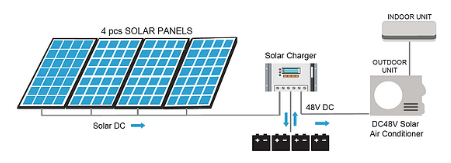
The function of charger controller with MPPT technique is to regulate the voltage and current coming from the solar panel going to the battery. The battery is the key components in PV-SA systems as it act as energy back-up for the renewable energy systems. It also functions as storage devices for storing PV generated electricity during cloudy days and at night. In order to apply this system in AC load, the inverter is needed to convert the DC electricity generated by the PV panel into AC. The AC load is a common type of load and easily available with cheaper in price.
Modelling of the DC air conditioning systems
Model of the solar panel
In order to account for the physical phenomena that have entered the cell level. For modeling incident luminous flux shunted by a diode reflecting the cell’s polarization phenomenon, the photovoltaic cell is equivalent to a current source. A series resistance R’s models the losses of material which must be as low as possible and a shunt resistance Rsh models the leakage current as shown in the following figure
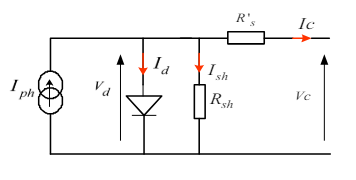
The expression of the current Ic delivered by the photovoltaic cell is:

And the current Id of the junction is:

We deduce the expression of the current: Ic

The photo-generated current Iph of the photovoltaic cell depends directly on the sunshine and proportional to the temperature and can be estimated by the following equation
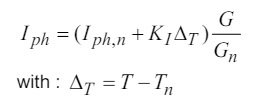
The equation for the temperature dependence of the inverse saturation current of the diode I0 can be expressed by the following equation
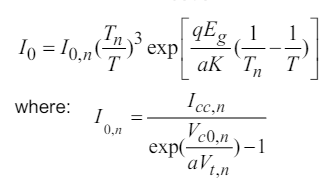
For a given illumination and temperature, the appearance of the characteristic is given by figure 3 It is characterized by three remarkable points, the maximum power point, the short-circuit point and the open-circuit point.
The cell’s power output reaches a limit, which represents the optimal operating point (PPM). By canceling the voltage, we obtain

The open circuit voltage is the voltage for which the current delivered by the cell is zero.

In the figure 4 we visualize the current vs voltage and power vs voltage characteristics for varying climatic conditions. The electrical characteristic of the photovoltaic cell is not fixed, it depends on the temperature and the incident irradiation.
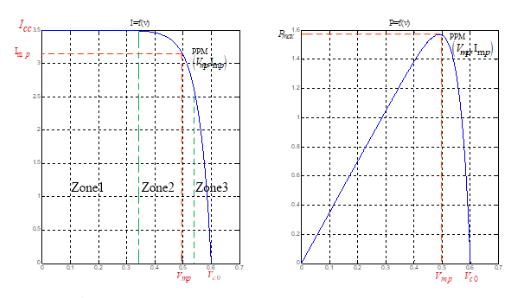
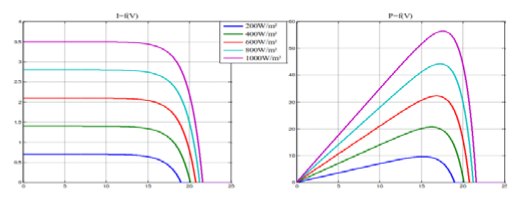
The figure 5 shows that the sun mainly influences the current and the power delivered since the current is proportional to the illumination. While the voltage varies very
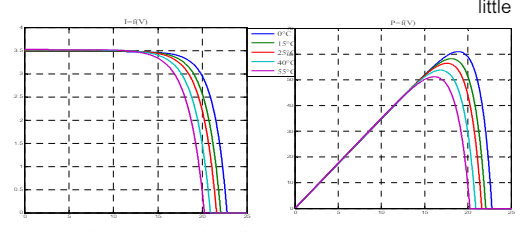
The open circuit voltage increases slightly each time as the illumination increases.
Model of the Brushless DC motor (BLDCM)
BLDC motors have many advantages over AC motors. A few of these are: High dynamic response, High efficiency, Long operating life, Noiseless operation and Higher speed ranges.
BLDC’s main disadvantage is higher cost which arises from two issues. First, BLDC motors require complex electronic speed controllers to run. Brushed DC-motors can be regulated by a comparatively trivial variable resistor (potentiometer or rheostat), which is inefficient but also satisfactory for cost-sensitive applications.
The BLDCM has three stator windings and a permanent magnet rotor on the rotor. Rotor induced currents can be neglected due to the high resistivity of both magnets and stainless steel. No damper winding is modeled the circuit equation of the three windings in phase variables are obtained
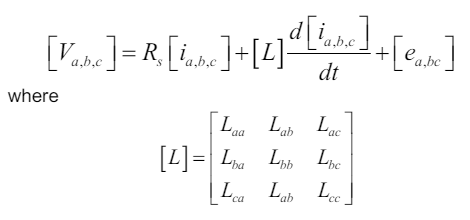
where Va, Vb and Vc are the stator phase voltages, R is the stator resistance per phase; ia, ib and ic are the stator phase currents; Laa, Lbb and Lcc are the self-inductance of phases a, b and c; Lab, Lbc, and Lbc are the mutual inductances between phases a, b and c; e are the phase back electromotive forces .It has been assumed that resistance of all the winding are equal.
The following relationships hold true for circuits that use a dc voltage controller or pulse-width modulation where Vd* denotes the relative voltage value, and VDC denotes the source dc voltage.

If magnetic saturation is accounted for, the relation binding the magnetizing current and the magnetizing flux is nonlinear, as the figure 6 indicates. To avoid cross-saturation complexities, in the main equations the magnetic saturation is introduced independently along the d and q axes. In addition, since the air-gap is uniform the no load magnetization curve is valid for both axes.
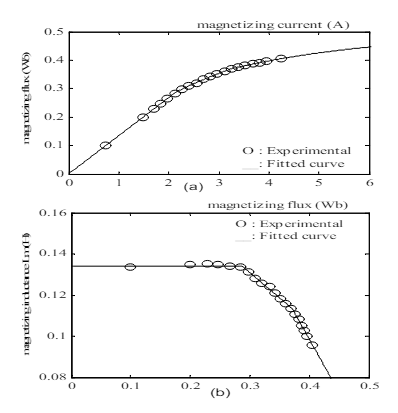
A program is developed using MATLAB to simulate the BLDCM model with speed controller. A numerical technique namely Fourth Order Rung-Kutta method was used to get the solution of the mathematical model for the variables voltage and currents. The speed controller and switching logic of current controller are used in this simulation. The simulation result for the electromagnetic force (EMF) of phase a,b and c are shown Figure 7. The main attribute of this model is to achieve the ideal characteristics of the motor as stated before, which is obtained by the developed ideal Back EMF block as shown in Fig.7.
The counter electromotive force of phase a, b and c detection methods are commonly used to know the position of the motor at all times.
According to the figures bellows, we deduce when the brushless DC motor is fixed, no counter electromotive force is generated; therefore, there is no information on the position of the stator and rotor, for this we must add a position sensor to detect the rotor and stator position. The proposed model of BLDCM is simulated in MATLAB, simulation results under load conditions are showing proper performance of model. Output characteristics and simplicity of model make it effectively useful in design of BLDC motor drives with different control algorithms in the air conditioning application.
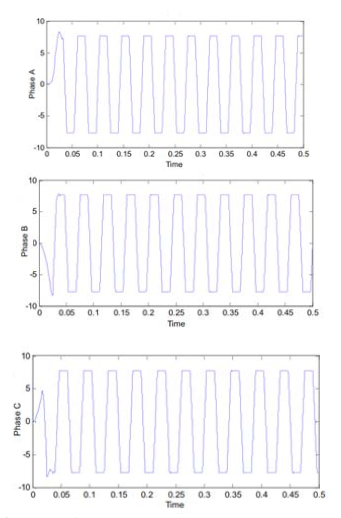
However, a brushless DC motor belongs to a rather new type of motor, and therefore Its performance ought to be improved further. Such as air conditioners will be demanded more in the future, so the authors would like to make efforts to improve performance energy preserved consumer appliances of the motor and reduce its manufacturing cost.
Conclusion
This work focuses on the modeling and simulation of the complete of grid PV-air conditioning system using BLDCM is described in this paper. The description of the PV panels and V-I characteristics are presented. Also, the effectiveness of the mathematical model of BLDM is established by performance prediction over a wide range of operating conditions. To Improve an energy efficiency in an entire variable speed range from those of conventional introducing a new rotor construction compressor motors, and the new brushless DC motor has been improved.
Acknowledgements: The authors extend their appreciation to the Deputyship for Research & Innovation, Ministry of Education in Saudi Arabia for finding this research work through the project number (20/11)
REFERENCES
[1] Tamer KHATIB, Azah MOHAMED, A Reliable Maximum Power Point Tracker for Photovoltaic Systems. PRZEGLĄD ELEKTROTECHNICZNY (Electrical Review), ISSN 0033-2097, R. 88 NR 2/2012
[2] Hui Ren, Wenhao Cai: Research on Grid-Connected Photovoltaic System Based on Improved Algorithm. PRZEGLĄD ELEKTROTECHNICZNY, , R. 98 NR 7/2019
[3] Amina ECHCHAACHOUAI, Soumia EL HANI, Ahmed HAMMOUCH. Comparison of three estimators used in a sensorless MPPT strategy for a wind energy conversion chain based on a PMSG PRZEGLAD ELEKTROTECHNICZNY, ISSN 0033-2097, R. 94 NR 3/2018
[4] D.S. Parker and J. R. Sherwin, Development of high efficiency air conditioner condenser fan, Transaction American Society of Heating Refrigerating and Air Conditioning Engineers. (2005)
[5] Mittal, V., Kasana, K.S. and Thakur, N.S. The Study of Solar Absorption Air-Conditioning Systems. Journal of Energy in Southern Africa, 16, 59-66. 2005.
[6] Umberto, D., Stefania, P. and Paolo, S. Solar-Powered Cooling Systems: Technical and Economic Analysis on Industrial Refrigeration and Air-Conditioning Applications. Applied Energy, 86, 1376-1386. 2009.
[7] Koroneos, C., Nanaki, E. and Xydis, G. Solar Air Conditioning Systems and Their Applicability: An Exergy Approach. Resources, Conservation and Recycling, 55, 74-82. 2015.
[8] Nkwetta, D.N. and Smyth, M. The Potential Applications and Advantages of Powering Solar Air-Conditioning Systems Using Concentrator Augmented Solar Collectors. Applied Energy, 89, 380-386. 2012.
[9] La, D., Dai, Y.J., Li, Y., Ge, T.S. and Wang, R.Z. Case Study and Theoretical Analysis of a Solar Driven Two-Stage Rotary Desiccant Cooling System Assisted by Vapor Compression AirConditioning. Solar Energy, 85, 2997-3009. 2011.
[10] Arteconi, A., Ciarrocchi, E., Pan, Q., Carducci, F., Comodi, G., Polonara, F., Wang, R., 2017. Thermal energy storage coupled with PV panels for demand side management of industrial building cooling loads. Applied Energy 185,1984–1993.
[11] Noro, M., Lazzarin, R.M., 2014. Solar cooling between thermal and photovoltaic: An energy and comparative study in the Mediterranean conditions. Energy 73, 453-464.
[12] J. Shen, Z. Zhu, D. Howe, and J. Buckley, “Fuzzy logic speed control and current-harmonic reduction in permanent magnet brushless ac drives,” IEE Proceedings-Electric Power Applications, vol. 152(3), pp. 437-446, 2005.
[13] Z.Q. Zhu, J.X. Shen, D. Howe, Flux-weakening characteristics of trapezoidal back-emf machines in brushless DC and AC modes, Proc. Int. Power Electronics and Motion Control Conf., IPEMC, (2006), Shanghai, China.
[14] G. Liu, W.G. Dunford, Comparison of sinusoidal excitation and trapezoidal excitation of a brushless permanent magnet motor, Power Electronics and Variable-Speed Drives, 1991., Fourth International Conference, pp.446,450, (1991).
[15] Zhao, M.; Liu, X.; Su, H. Robust adaptive speed control of disturbed brushless direct current motor. In Proceedings of the 2017 Eighth International Conference On Intelligent Control and Information Processing (ICICIP), Hangzhou, China, 3–5 November 2017; pp. 141–146.
[16] Merugumalla, M.K.; Kumar, N.P. FFA-based speed control of BLDC motor drive. Int. J. Intell. Eng. Inform. 2018, 6, 325–342.
[17] Yinod Kr Singh Patel, AKPandey, “Modeling and Simulation of Brushless DC Motor Using PWM Control Technique”,International Journal of Engineering Research and Applications ISSN: 2248-9622, vol. 3, Issue 3, May-Jun 2013, pp.612-620.
[18] P.Nagasekhar Reddy, “Modeling and Analysis of PI Controller Based Speed Control of BrushlessDCMotor Drive”, International Journal of Engineering Sciences & Research Technology,1.852, September, 2013, pp.2226-2231.
[19] D.S. Parker and J. R. Sherwin, Development of high efficiency air conditioner condenser fan, Transaction American Society of Heating Refrigerating and Air Conditioning Engineers. (2005)
[20] M. Mahmud, S. M. A. Motakabber, A. H. M. Z. Alam, A. N. Nordin, “Adaptive PID controller using for speed control of the BLDC motor”, 2020 IEEE International Conference on Semiconductor Electronics (ICSE),2020.
[21] D. Potnuru, D., “Experimental implementation of Flower Pollination Algorithm for speed controller of a BLDC motor”, Ain Shams Engineering Journal, Vol. 10(2), pp. 287–295, 2019.
[22] M. Mahmud, S. M. A. Motakabber, A. H. M. Z. Alam, A. N. Nordin,“Control BLDC Motor Speed using PID Controller”, International Journal of Advanced Computer Science and Applications(IJACSA), Vol.11(3), pp. 477-481, 2020.
Authors: dr. Mohamed Arbi KHLIFI, Faculty Engineering, Islamic University of Madinah, Al-Madinah Monawarah, KSA, Abo Bakr Al Siddiq, Al Jamiah, Medina 42351, E-mail: medarbi.khlifi@gmail.com; dr Marwa Ben Slimene, College of Computer Science and Engineering, University of Haʼil, Haʼil, KSA, PO Box 2440. Ha’il – 81451, E-mail: benslimene.marwa@gmail.com.
Source & Publisher Item Identifier: PRZEGLĄD ELEKTROTECHNICZNY, ISSN 0033-2097, R. 97 NR 6/2021.doi:10.15199/48.2021.06.22